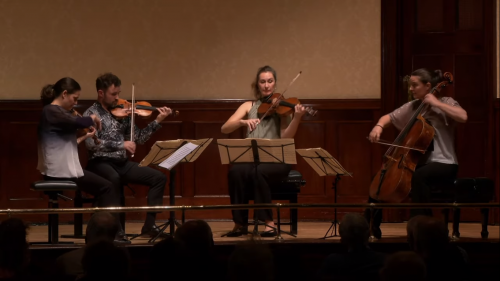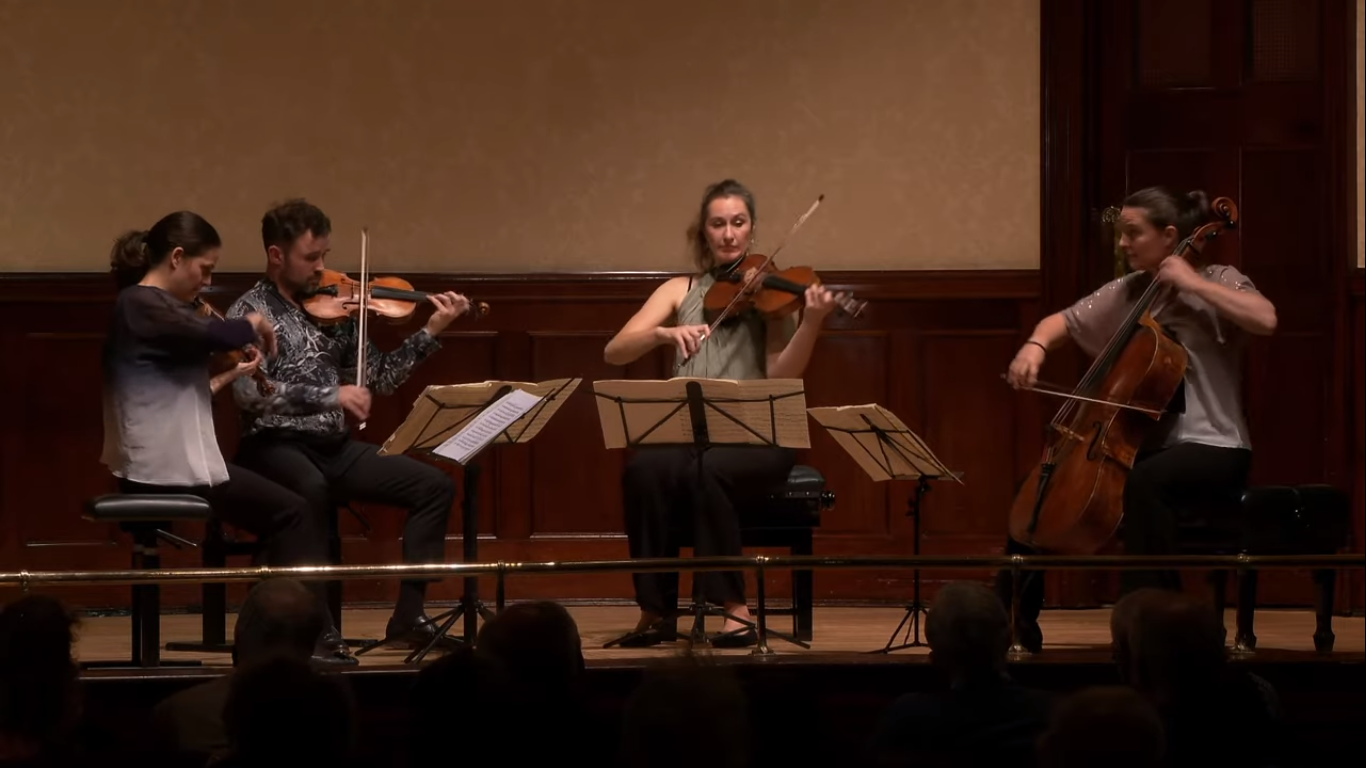 United Kingdom Beethoven: Elias String Quartet (Sara Bitlloch, Donald Grant [violins], Simone van der Giessen [viola], and Marie Bitlloch [cello]). Wigmore Hall, London, 6.10.2020. (CSa)
United Kingdom Beethoven: Elias String Quartet (Sara Bitlloch, Donald Grant [violins], Simone van der Giessen [viola], and Marie Bitlloch [cello]). Wigmore Hall, London, 6.10.2020. (CSa)

Beethoven – String Quartet in E flat Op.127; String Quartet in E minor Op.59 No.2 ‘Razumovsky’
There is something about live audience concerts during the COVID-19 pandemic reminiscent of classical musical events during the Blitz. True, there are no direct parallels between the crowds who braved the bombs to hear Myra Hess performing Bach at the National Gallery, and the lucky few who attended Wigmore Hall to hear the Elias Quartet play Beethoven. Nonetheless, the Wigmore’s sensible decision to reopen its doors to intrepid concertgoers in search of cultural solace suggests that the ‘Keep Calm and Carry On’ approach in times of adversity is as relevant now as it was then.
The Elias Quartet – the name is derived from Mendelssohn’s oratorio, Elijah or in German Elias – was formed in 1998 at Manchester’s Royal Northern College of Music. This outstanding group of chamber musicians participated in BBC Radio 3’s New Generation Artists scheme almost a decade ago, and in 2015 completed their innovative Beethoven Project, playing all of Beethoven’s quartets at the Wigmore, and recording them on the Hall’s own label.
The group returned earlier this week in a programme consisting of the first of Beethoven’s six ‘late quartets’ – Op.127 in E flat, and the second of the ‘Razumovsky’ quartets – Op.59 No.2 – from the composer’s ‘middle period’.
Unlike his other late quartets, Op.127 is the only one written in the conventional four movement form. Although its first performance in 1825 by Ignaz Schuppanzigh’s under-rehearsed quartet was a failure, Beethoven informed his publishers that he supposed it to be ‘the greatest and most beautiful’ piece he had written. The Elias’s playing, assisted by the Hall’s superb acoustic, made for bell-like clarity and warmth of tone. The majestic introduction of the work’s first movement was contrasted effectively with an expansive account of the ensuing Allegro. The slow, rhapsodic second movement, comprising a set of six brilliant variations, began notably with skilful interplay between the group’s leader (Sara Bitlloch) whose singing violin melody melded beautifully with the gently insistent syncopation of the cello (played by Sara’s sister Marie). The conversation between the sisters was resumed in the penultimate variation, a joyous duet richly decorated with trills and arpeggios. The Scherzo was taken at a sprightly pace, and fairly bristled with fitful energy and complex rhythms. The players brought buoyancy and rustic cheer to the Finale, before transporting us in a coda of rare intensity.
After a short sedentary interval during which the masked and socially distanced audience barely coughed, the musicians returned to the stage to give a spirited performance of Op.59. The quartet was one of three to be commissioned by Count Razumovsky, the Russian ambassador to Vienna, and was published in 1808. It is said that the music’s technical complexity led violinist Felix Radicati, one of its original performers, to complain to the composer that [these quartets] were ‘not music’.
‘They are not for you, but for a later age’, Beethoven responded.
As Edward Dusinberre of the Takàcs Quartet has pointed out, Op.59, with its interrupted rhythms and dialogue between the different parts, ‘must have perplexed anyone encountering them for the first time … and simply did not behave as classical music should’. In the Elias’s hands, the music still has the capacity to shock as well as to thrill. Their account successfully harnessed exuberance with restraint, so maintaining an excellent balance between the score’s eighteenth-century classical foundations and its iconoclastic Romanticism. In a dramatic first movement Allegro, the players underscored Beethoven’s turbulent passages and dynamic shifts with long silences to great effect. The hymn-like slow movement was tenderly played, while the skittish Allegretto was driven forward with almost breathless urgency. The finale, a frenzied Slav dance marked Presto, proceeded at an exhilarating pace, but never at the expense of fine musicianship or loss of control.
Chris Sallon
Available to see until 5 November for more information go the Wigmore Hall website click here.
